AI assistants like ChatGPT, Gemini, and Perplexity have become the new places people turn to for answers—handling millions of prompts every day. Even Google now uses AI to generate summaries right at the top of search results.
This shift happened fast. In 2024, AI Overviews rolled out to millions of searches, ChatGPT climbed into the top ranks of global websites, and the once-reliable #1 Google spot began losing a third of its clicks. Suddenly, SEO wasn’t just about rankings anymore.
Some marketers panicked, others brushed it off. But AI has changed how people discover brands and where visibility happens.
This isn’t the end of SEO, it’s the next chapter. The fundamentals still matter, but the strategy needs to evolve.
So, here’s what’s changed, what hasn’t, and how to stay visible in the age of AI search.
For years, Google has been moving away from simple keyword matching. But the inclusion of their Gemini large language model (LLM) took this to another level.
Pre-LLM systems could recognize that “Apple” the company was different from “apple” the fruit. They could connect related concepts. But they couldn’t truly comprehend nuance, handle complex multi-step reasoning, or synthesize information across dozens of sources the way a human would.
LLMs changed that. Search engines with an LLM layer understand context at a depth that lets them interpret ambiguous queries, infer unstated intent, and connect disparate pieces of information in ways previous systems couldn’t.
So, when you search something complex like “gift ideas from California under $50 for people who already have everything,” Google’s AI Mode (based on the Gemini large language model) doesn’t just look for pages with those exact words. Instead, it uses what’s called “fan-out queries”, breaking out your question into multiple related searches behind the scenes (in this case, 10 different searches).
Those fan-out queries might look like:
- “California artisan gifts under $50”
- “California food products budget-friendly”
- “Experience gifts California affordable”
- “Hard to shop for people gift ideas”
- “California-made practical items”
- “Gifts for people who don’t want more stuff”
- “California specialty products budget”
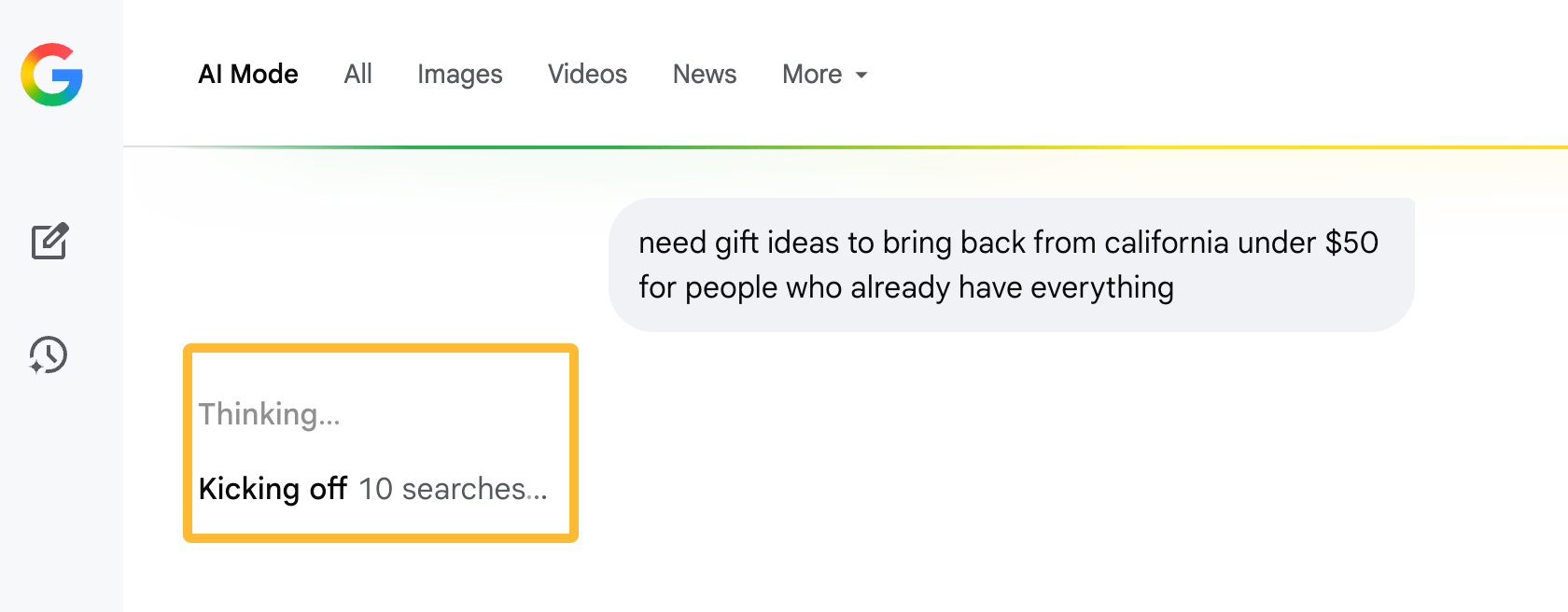
Or, when someone searches “best laptop for video editing under $1000 that’s not too heavy”, modern AI doesn’t just look for keyword matches. It genuinely understands the trade-offs between processing power, portability, and budget constraints.
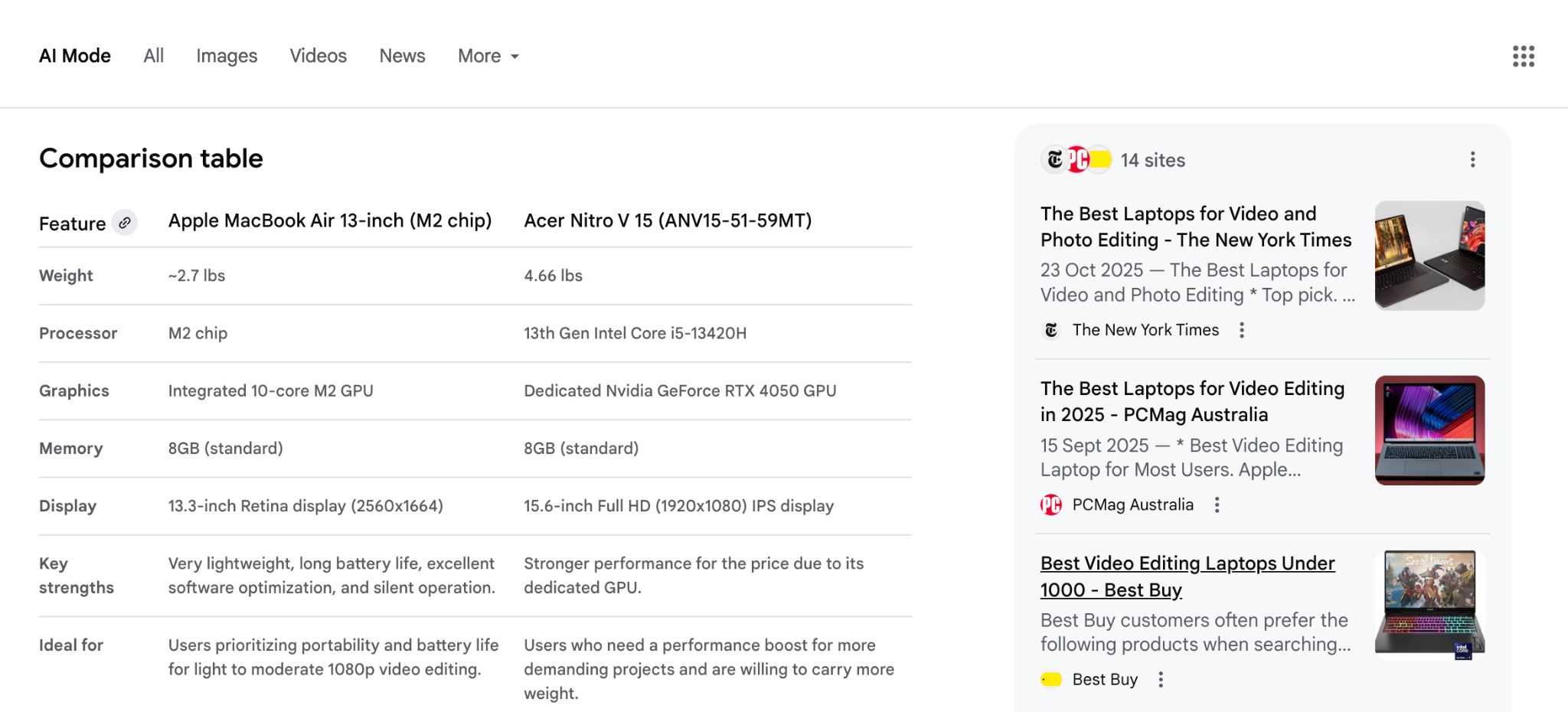
Google now understands the nuance of prompts and does the research legwork for users, rather than just handing you a list of links to click through.
Google’s AI Overviews now sit at the very top of search results, pulling insights from multiple sources to deliver instant, comprehensive answers. They occupy the most valuable real estate on the page—above every traditional result—and often satisfy the user’s query without a single click.
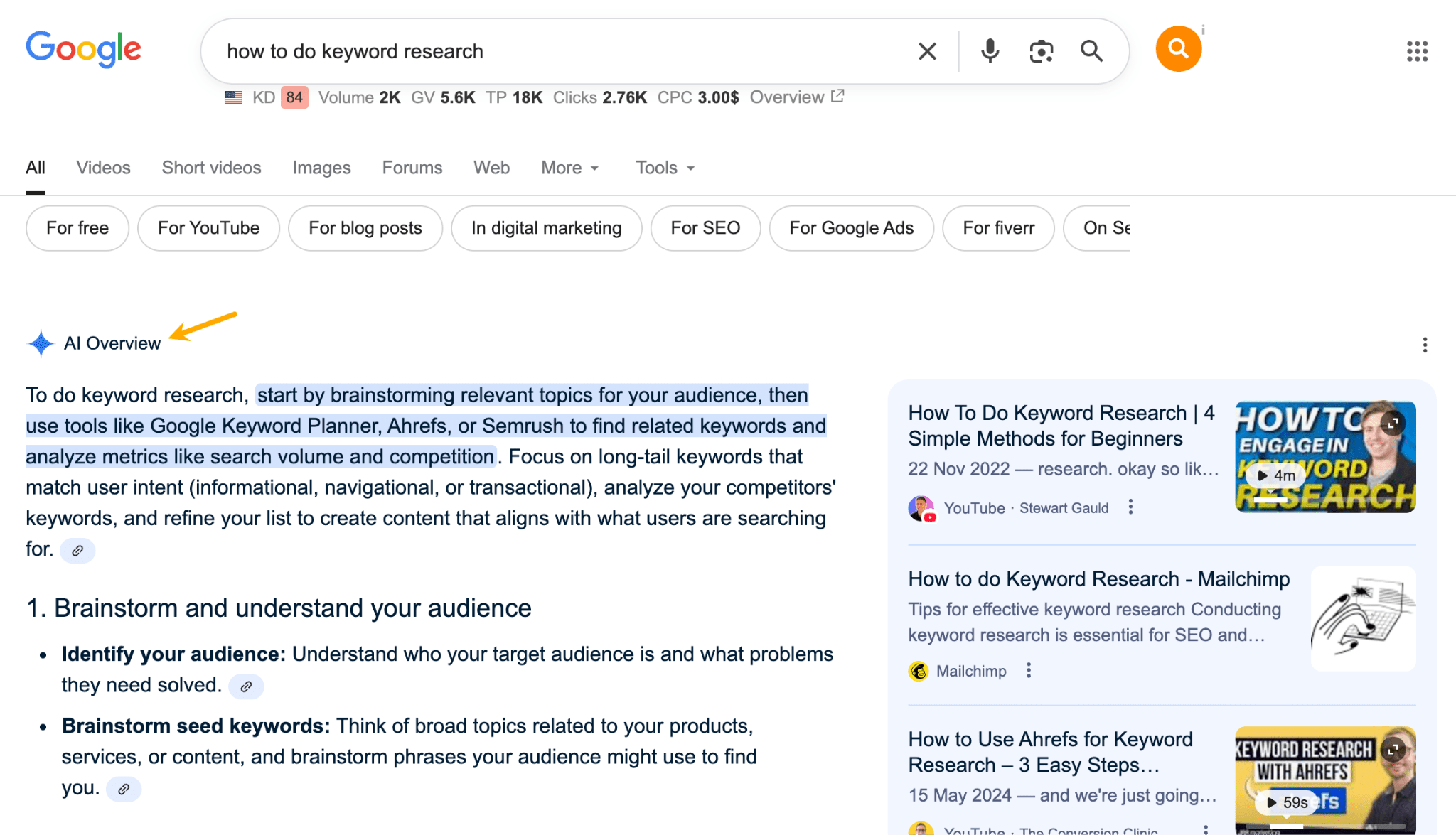
Because of that, even the #1 organic result has lost around 34% of its clicks when an AI Overview appears.
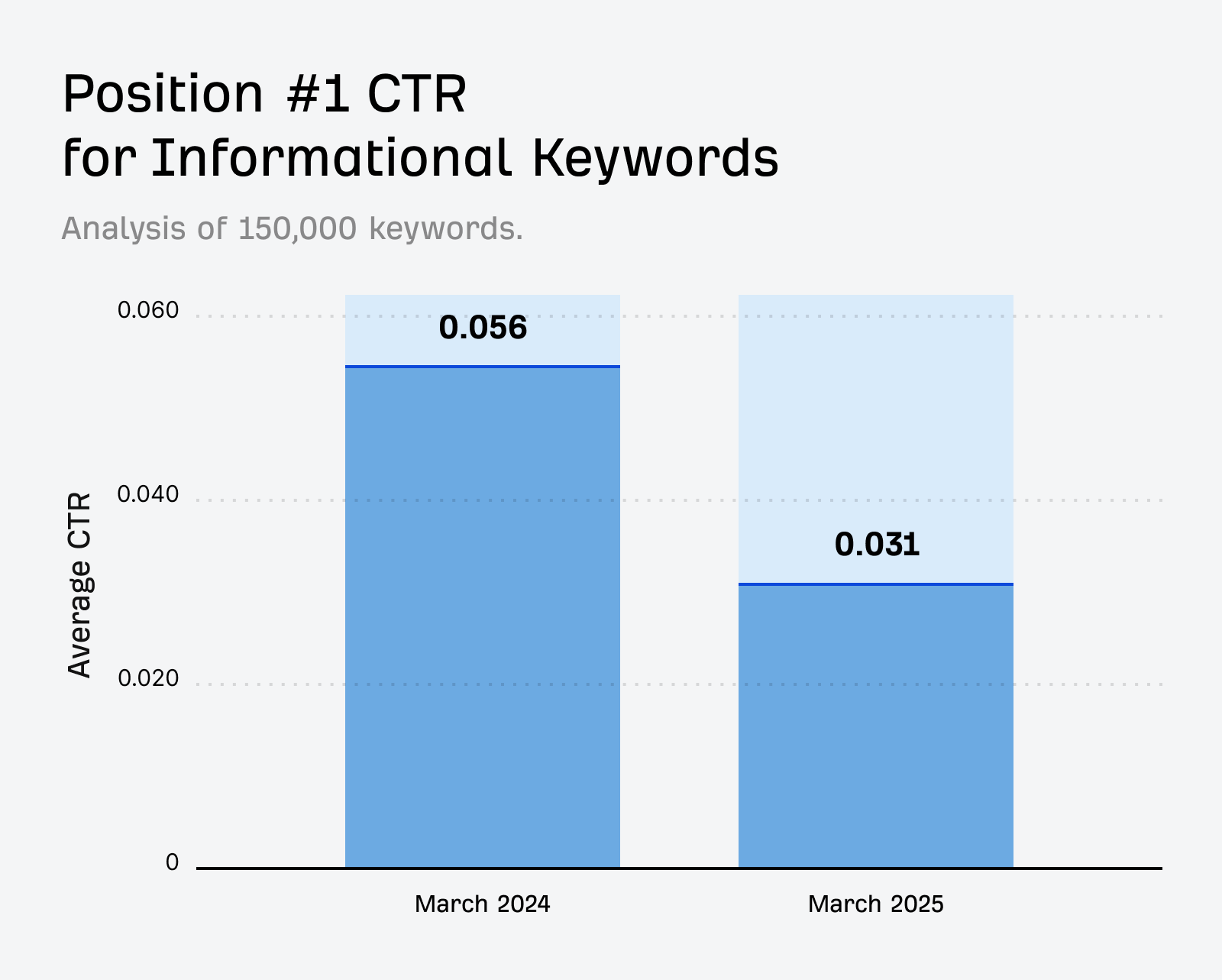
At first glance, being cited within an AI Overview might seem like a win, but the data tells a different story. A Pew Research Center study found that 99% of users who see an AI Overview don’t click any of the cited sources, and 26% close their browser entirely after reading the summary.
In contrast, about 8% of users click results in the traditional organic listings directly below the overview, meaning you may actually drive more traffic from those standard rankings than from being featured in the AI box itself.
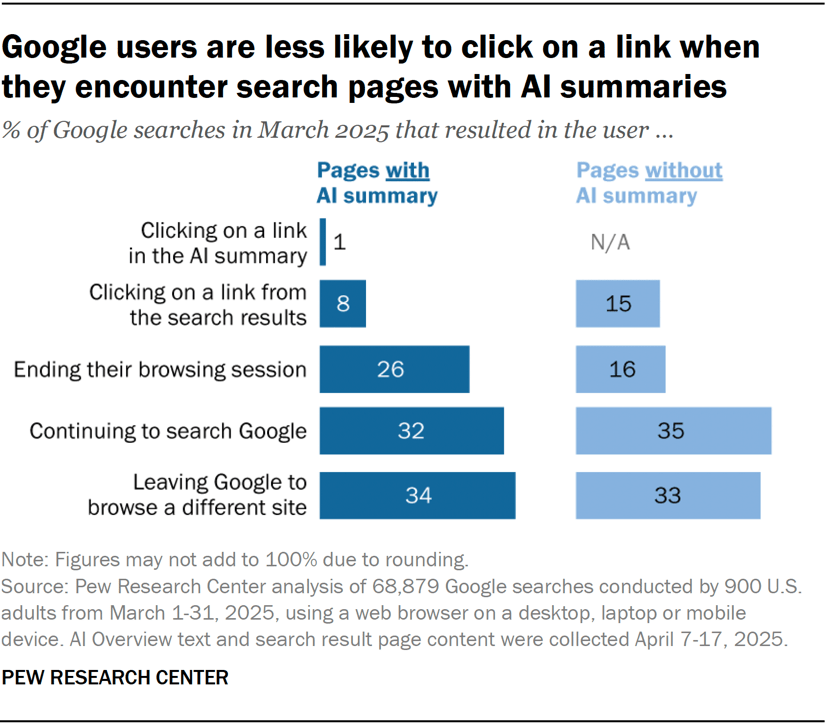
All of this compounds the growing zero-click search trend. Over half of all Google searches already ended without a single site visit in 2024, and AI Overviews are only accelerating that shift. Users who do click through tend to be more motivated, but overall discovery is increasingly happening on the results page itself—not on websites.
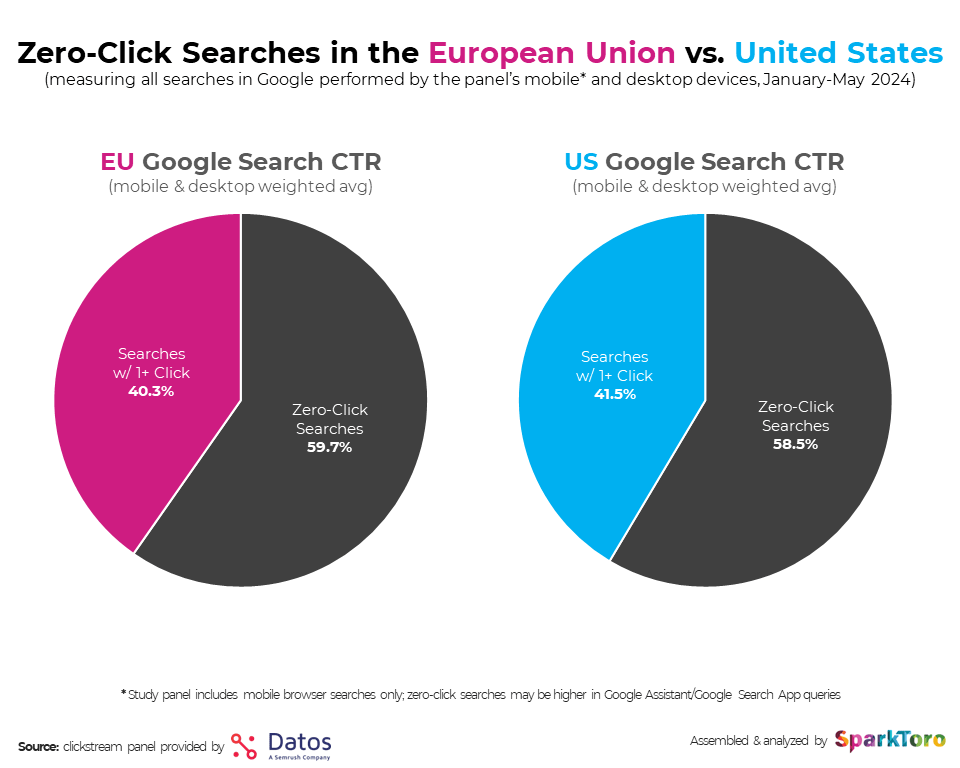
Since 98% of AI Overviews are informational, content focused on “how-to” or educational topics has been hit hardest.

Searches that show clear buying intent or mention specific brands are less influenced by AI. Whether in Google’s AI Overviews, AI Mode, or within large language models (LLMs), when users already know what they want to buy or which brand they prefer, AI tools usually display traditional search results instead of summarizing or replacing them.
A recent study by Kevin Indig, which analyzed 250 search tasks, found that Google’s AI Mode has an almost 100% zero-click rate. Users are now discovering products, comparing options, and forming opinions entirely within the AI interface—only clicking through when they’re ready to make a purchase.
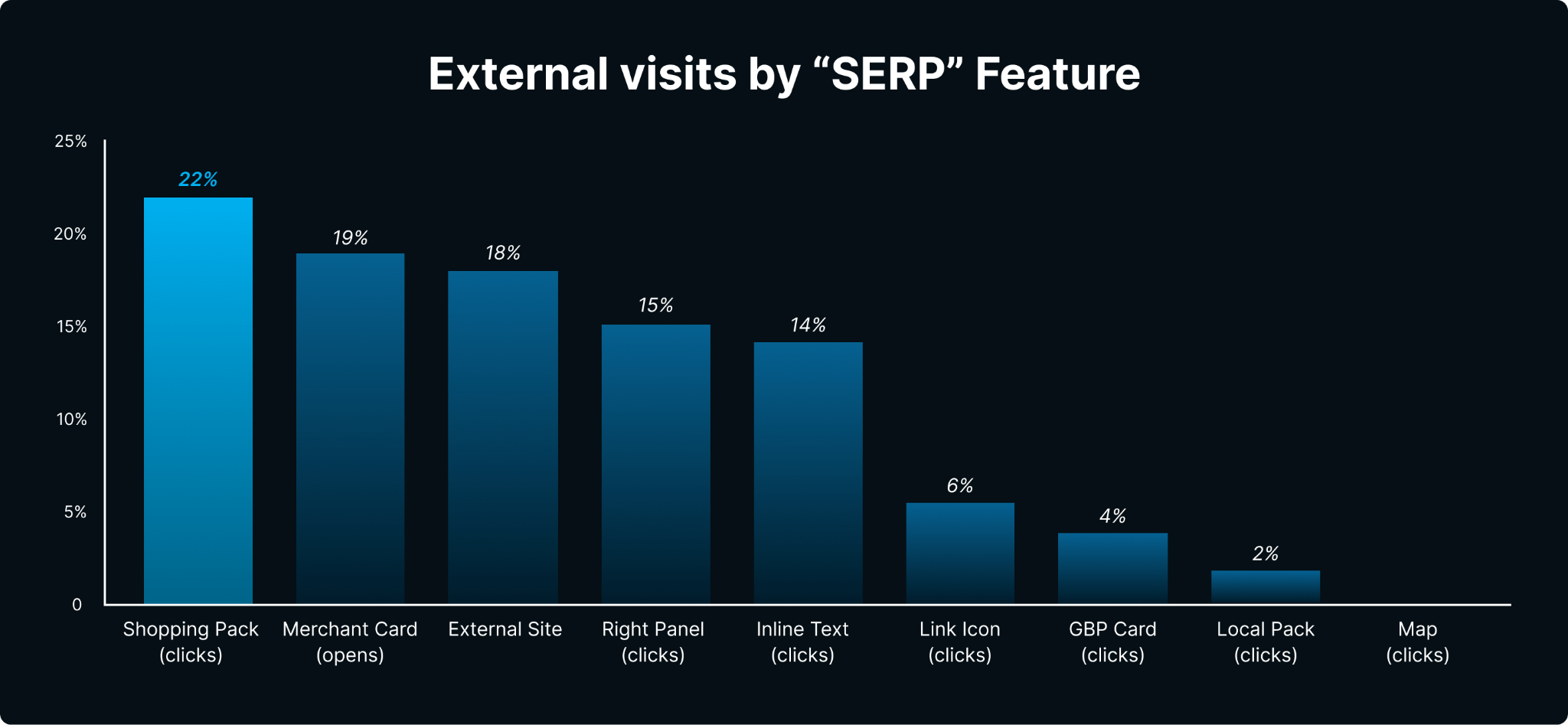
In other words, AI Mode consumes all top-of-funnel and middle-of-funnel activity, reserving clicks exclusively for transactions.
Here’s the silver lining: the users who actually click through from AI summaries are likely to be more valuable than before.
If someone sees an AI answer but still chooses to visit your site, they likely want something more—deeper information, a different perspective, or they’re closer to taking action.
In some cases, these clicks convert better than the old high-volume, low-intent traffic.
The keyword is “sometimes.” It depends on your specific situation. To illustrate, our analysis found that traffic from LLMs was responsible for 12% of signups, while accounting for only 0.5% of total clicks.
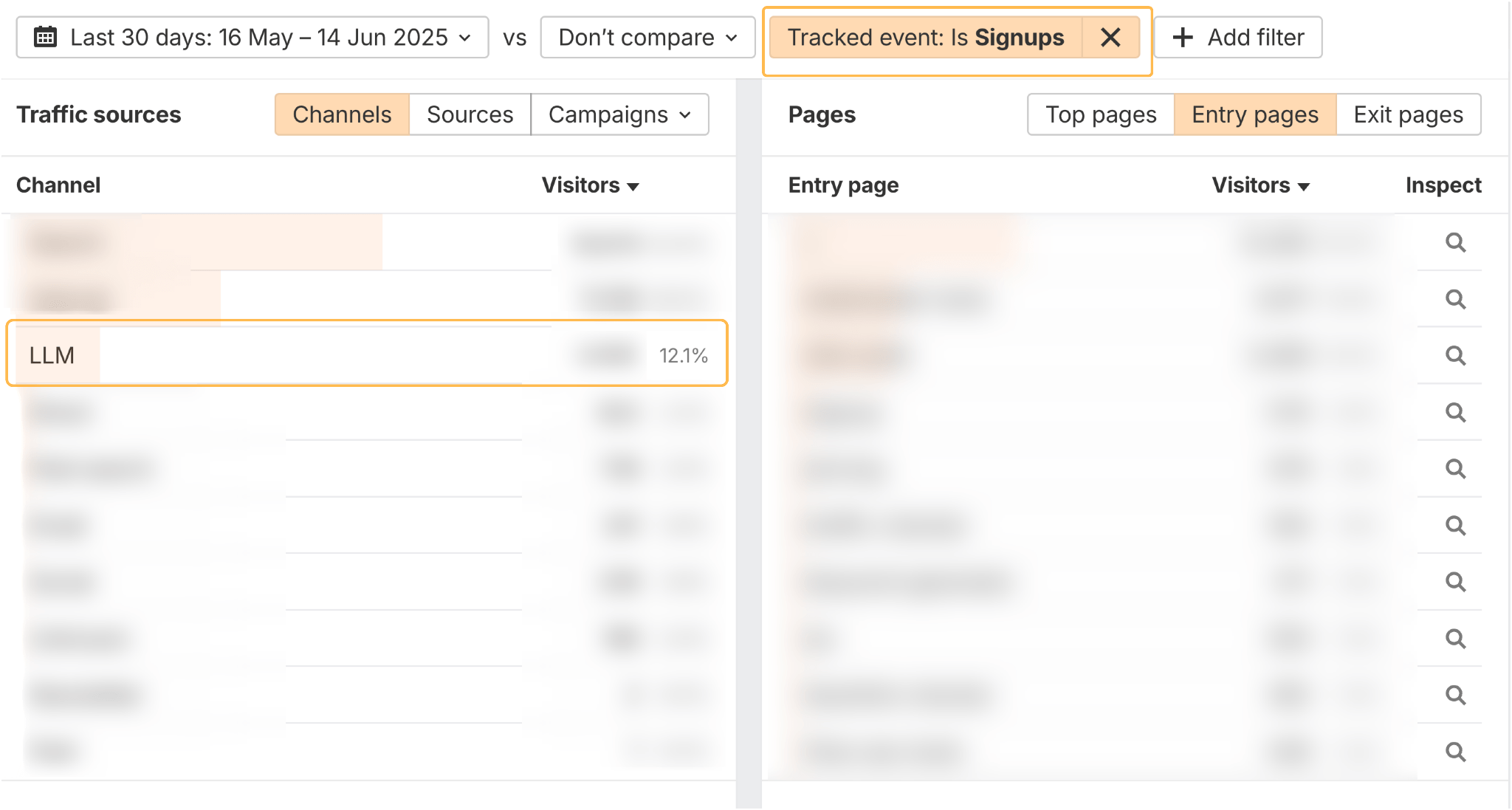
But another analysis by Amsive found that this can’t be extrapolated to all industry verticals.
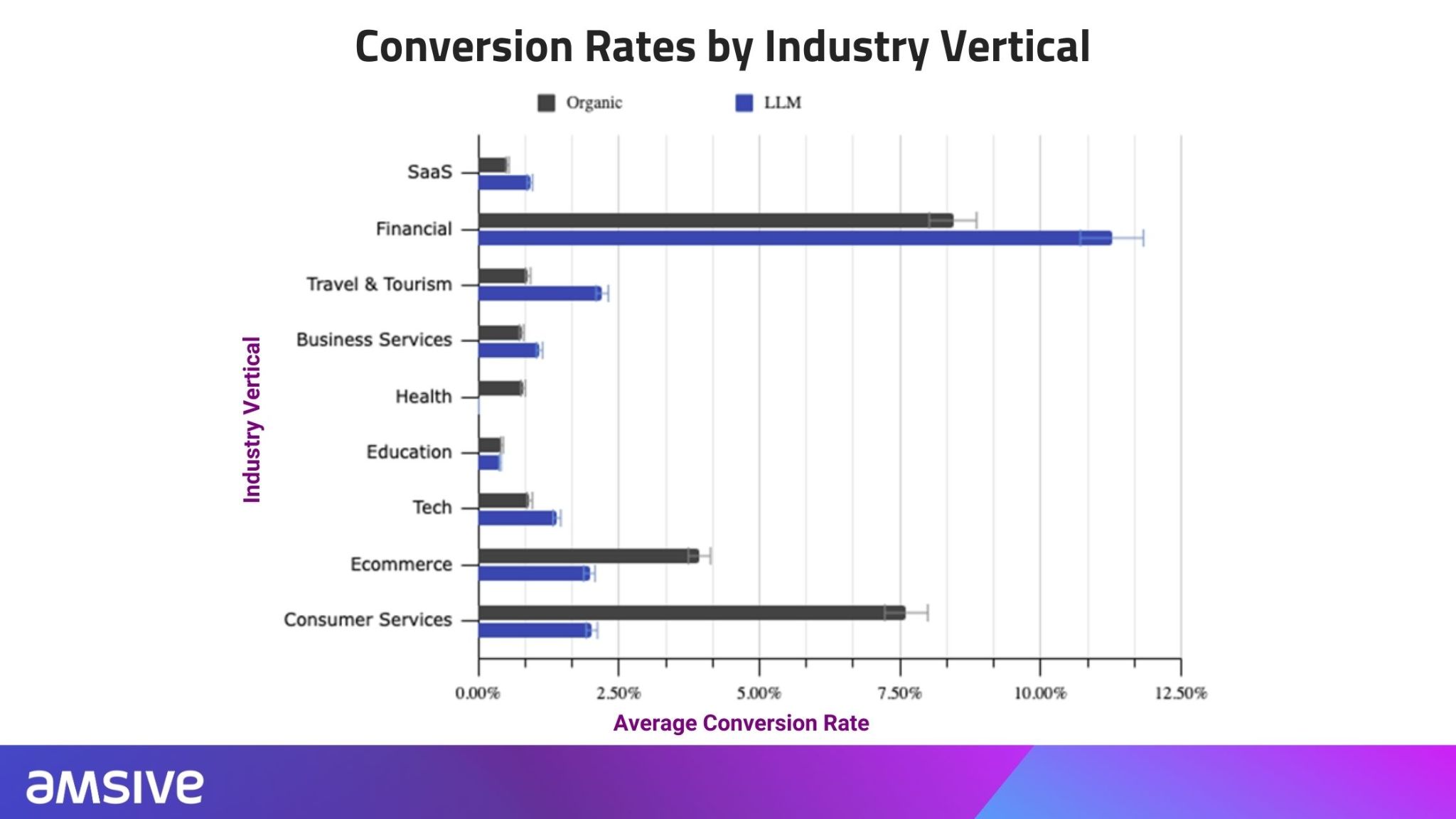
GEO, or Generative Engine Optimization, is the next stage in SEO’s evolution, driven by the rise of AI. It takes traditional SEO further by introducing a new channel, a new type of user experience, and an entirely new way to measure success.
While related terms like AEO (Answer Engine Optimization) or LLMO (Large Language Model Optimization) are sometimes used, the idea is the same: ensuring your brand is visible, cited, and accurately represented within AI-generated answers.
For marketers, this represents a new “battleground” for visibility—one where AI assistants, not just search engines, influence consumer decisions. Some brands are surfaced and recommended as trusted authorities, while others are simply left out of the conversation.
That doesn’t mean GEO replaces SEO. In fact, it builds on the same foundation. The difference lies in where and how visibility happens. Search and AI results draw from similar content pools, but how they surface and summarize that content can vary dramatically.
To earn mentions and citations in AI-generated answers, marketers will need to adapt familiar tactics—not invent entirely new ones. Strategies like influencer marketing, reputation management, and structured, semantically clear content are seeing a resurgence.
[note]A citation is when an AI attributes information to your content and includes a link to your site—usually for data, stats, or how-to content.
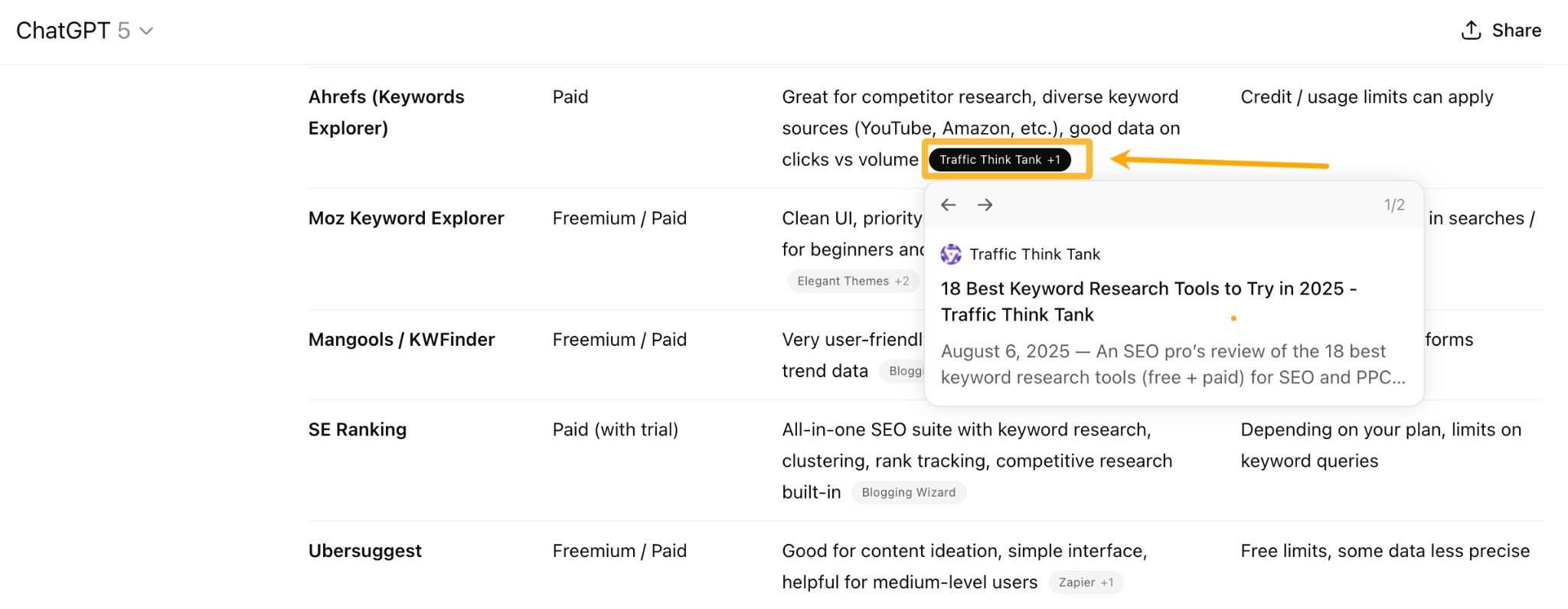
A mention is when your brand or product name appears in an AI-generated answer without a link, often in product recommendations.
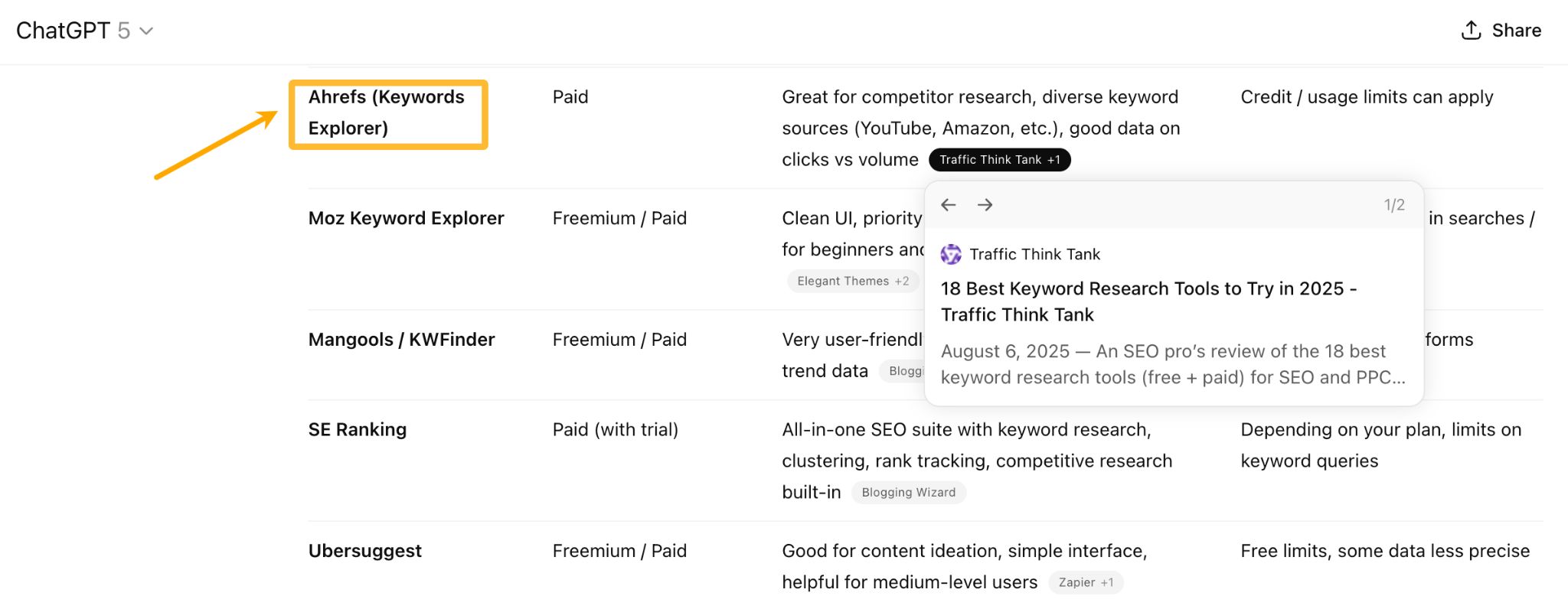
Every industry—and every brand—experiences AI visibility differently. But what AI understands about your brand likely comes from the same place it learns about ours: other people’s websites.
At Ahrefs, most AI-generated answers reference us without citing our site directly. Instead, they draw from reviews, news articles, forums, some social media, and blogs, combining that with the AI’s built-in knowledge to form their understanding.
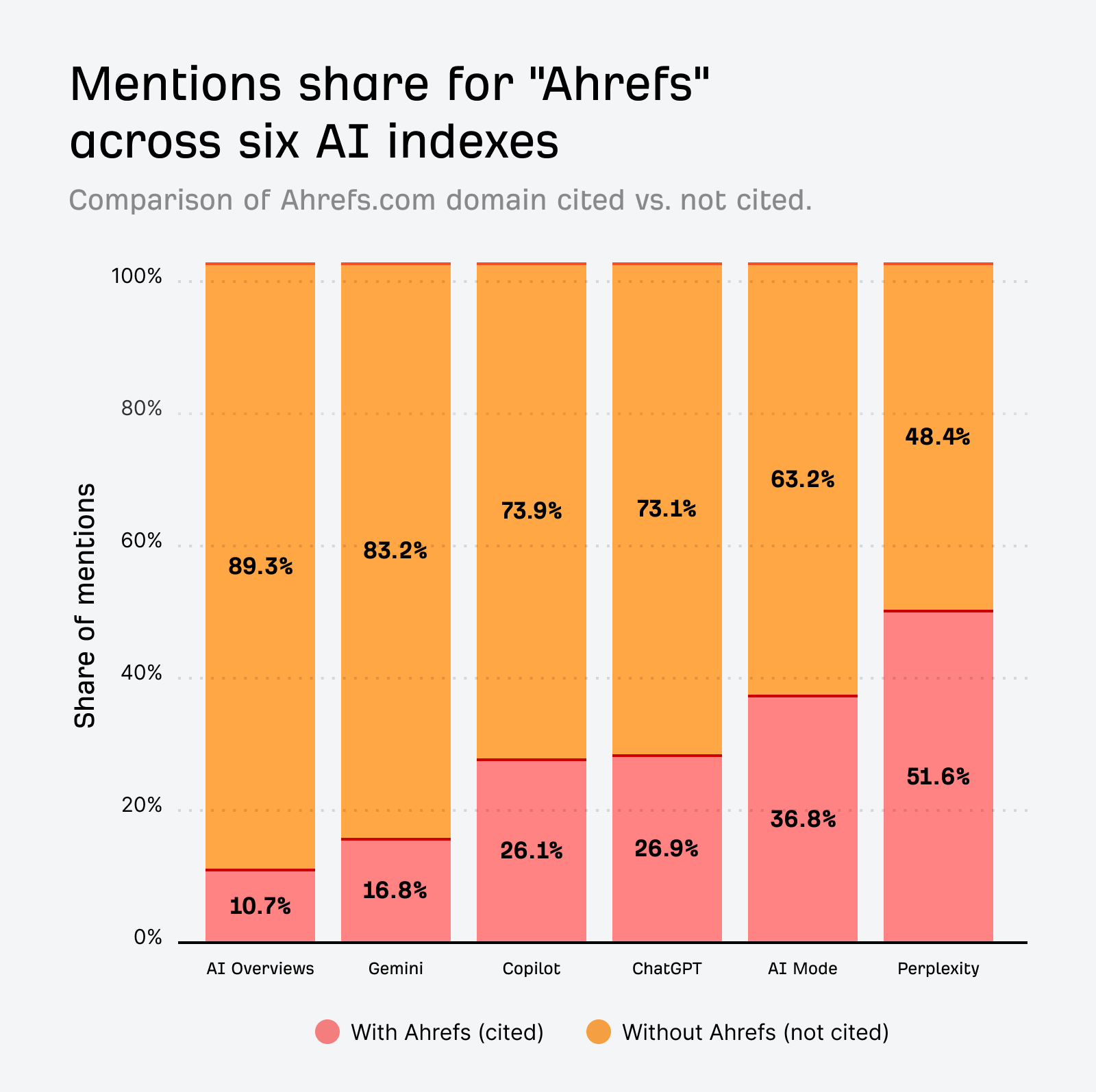
Interestingly, when we analyze potential reach across our Brand Radar indexes (reach = mentions x volume of keywords), the answers where Ahrefs is directly mentioned or cited perform significantly better in three of the six tracked AIs—specifically AI Mode, Gemini, and Perplexity.
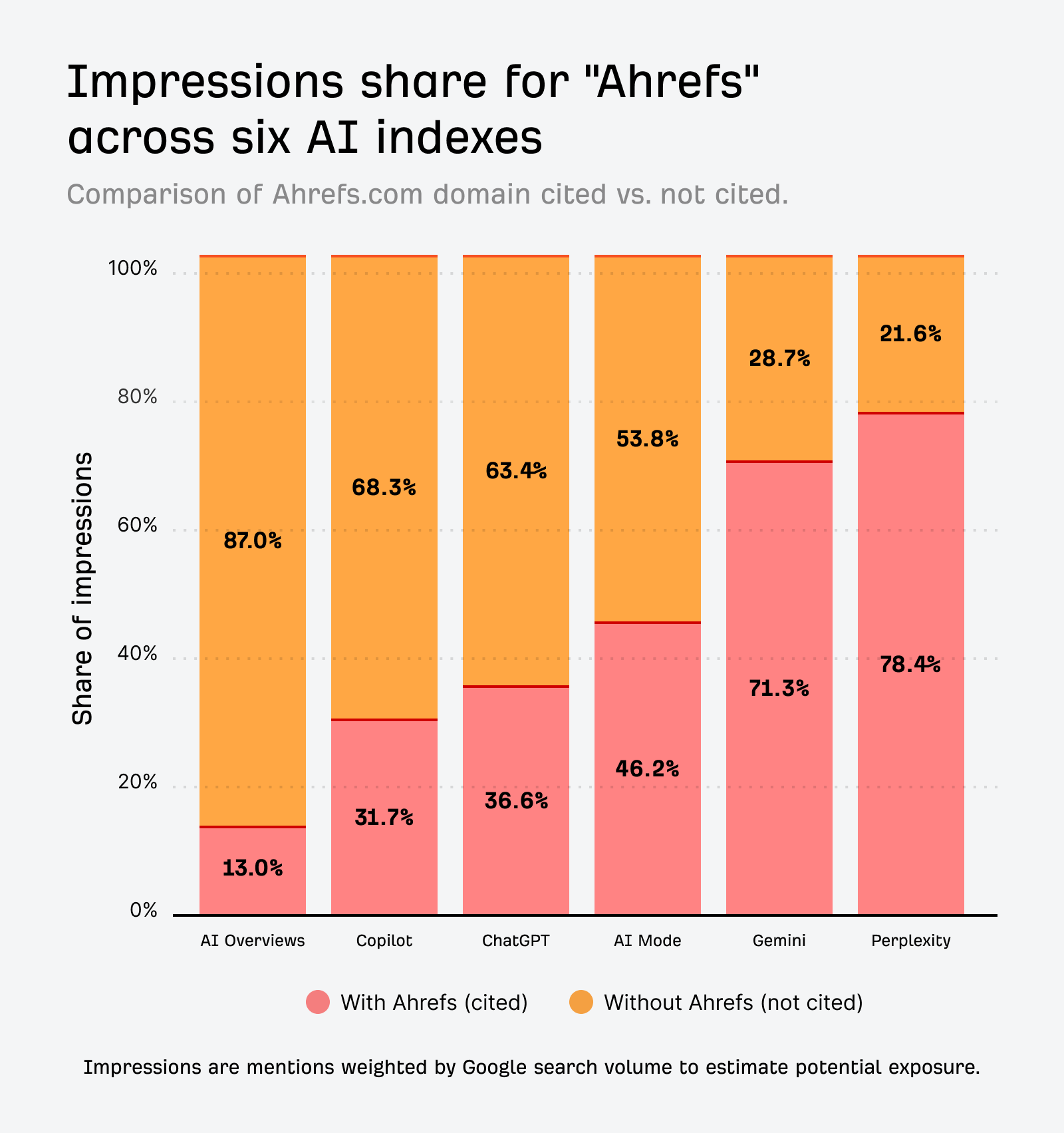 The takeaway here is that your broader online presence—and what others say about you—matters more than ever for how AI perceives and represents your brand.
The takeaway here is that your broader online presence—and what others say about you—matters more than ever for how AI perceives and represents your brand.
Traditional SEO tools show you rankings and clicks, but they don’t tell you how often AI mentions and cites your brand or how you compare to competitors in AI answers.
New AI visibility tools are emerging to fill this gap.
For example, Ahrefs’ Brand Radar can monitor your AI visibility across various major AI indexes.
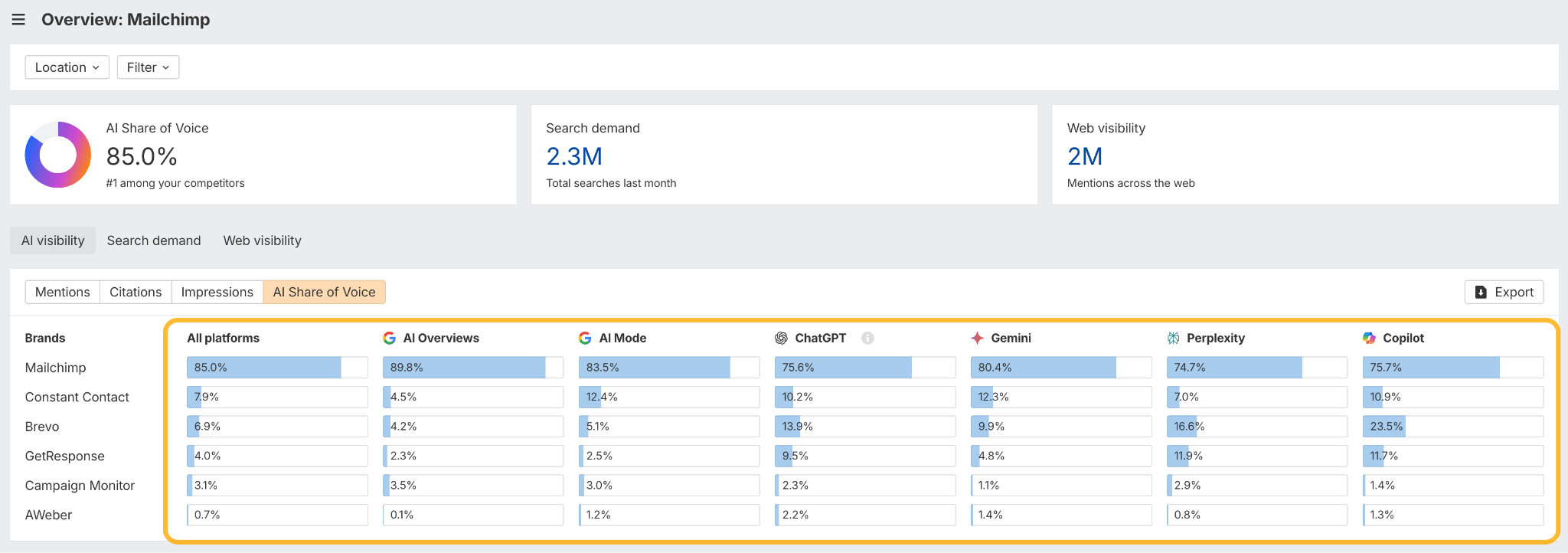
And show the topics you miss out on so you can create new content for them and/or contact cited sites to feature you, so you can boost your AI visibility.
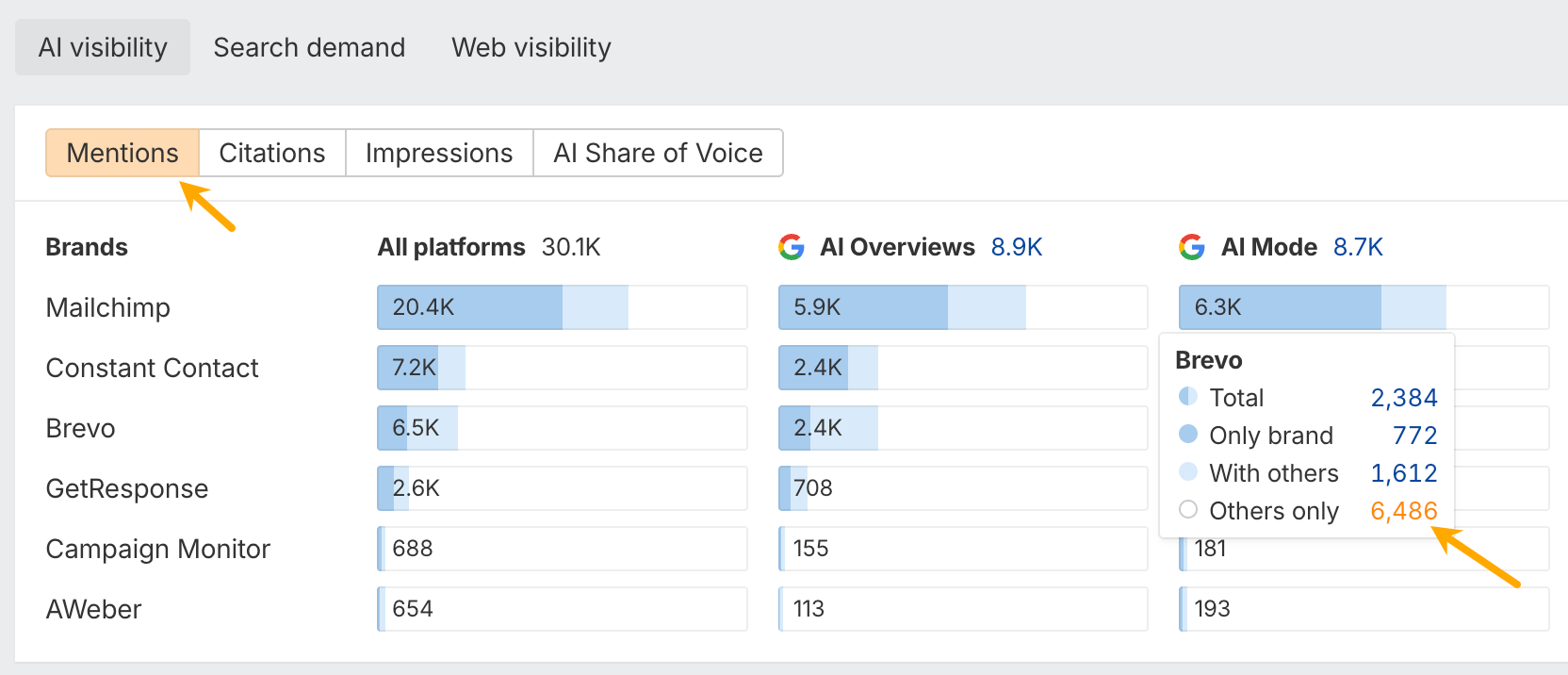
Most brands already have some AI visibility simply inherited from their existing organic presence in Google and the broader web. We do too—nearly 8,000 citations across Google’s AI experiences and LLMs—all achieved with zero AI-specific optimization, purely from traditional SEO.
But I suspect most brands haven’t started optimizing intentionally for AI visibility yet. It’s still early days. Those who begin now will have a real advantage—time to test, learn, and build authority before everyone else catches on.
The window won’t stay open forever. Once AI visibility becomes a mainstream priority, standing out will get much harder.
As mentioned earlier, optimizing for AI doesn’t really mean adopting brand-new tactics (assuming there even are any GEO-specific ones yet). It’s more about applying existing SEO practices with AI search in mind and tracking a different set of metrics. Here’s a quick video to help you get up to speed on optimizing for AI-driven search.
AI’s rapid rise in 2025 caught most marketers off guard. Budgets were cut, panic set in, and suddenly everyone needed to learn GEO—fast… or keep fighting to remind the world it’s still just SEO.

In one of my earlier posts, I called it what it is—a bit of hysteria. When you look at the data, traffic from all LLMs combined barely reaches 1%, while Google traffic has continued to grow during the same period that ChatGPT exploded in popularity. Yet many were already declaring the end of SEO.
Agencies and consultants rushed to offer GEO services, sometimes before fully understanding what it actually meant. It feels a lot like the early SEO days: plenty of hype, scattered experimentation, and very little consensus on what really works.
For example, for months, the main conversation on LinkedIn about LLMs and AI Overviews was that they were taking away website traffic. But more recently, I’ve started seeing the opposite perspective emerge, showing that AI referral traffic and organic search can actually grow together.

This shift reminds us that GEO is still taking shape — and those who stay curious, test often, and adapt early will be the ones to benefit most as it evolves.
Smart brands aren’t waiting for Google to reverse course on AI Overviews or the AI Mode. They’re diversifying fast by shifting investment away from informational content vulnerable to AI summarization and toward other channels.
For example, Seer Interactive agency has repositioned entirely, prioritizing thought leadership and organic social media—particularly LinkedIn—over traditional SEO, recognizing that while traffic volume is lower, quality and conversion rates are substantially higher.
The most comprehensive response is Search Everywhere Optimization (SEvO)—ensuring discoverability across all platforms where audiences search, including YouTube, TikTok, Reddit, Amazon, Pinterest, and AI assistants like ChatGPT.Traffic via organic social (largely LinkedIn) is probably the source we’re most focused on optimizing for. The traffic volume is smaller but it’s extremely high quality. I also think we’ll continue to be in a position to think about different layers of influence. You can’t focus on just one source or one channel. There is a lot of chaos in the SEO industry right now given all of the change. Our ICP is juggling a lot of priorities, she’s trying to educate herself on the changes in search while continuing to hit her OKRs while balancing budget cuts and headcount reduction. Our best bet is to be able to build trust with her, or rely on the trust we’ve previously built with our content, our presence in events, and our reputation.
Just look at TikTok’s numbers—Gen Z is using it like a search engine, and many even prefer it over Google.
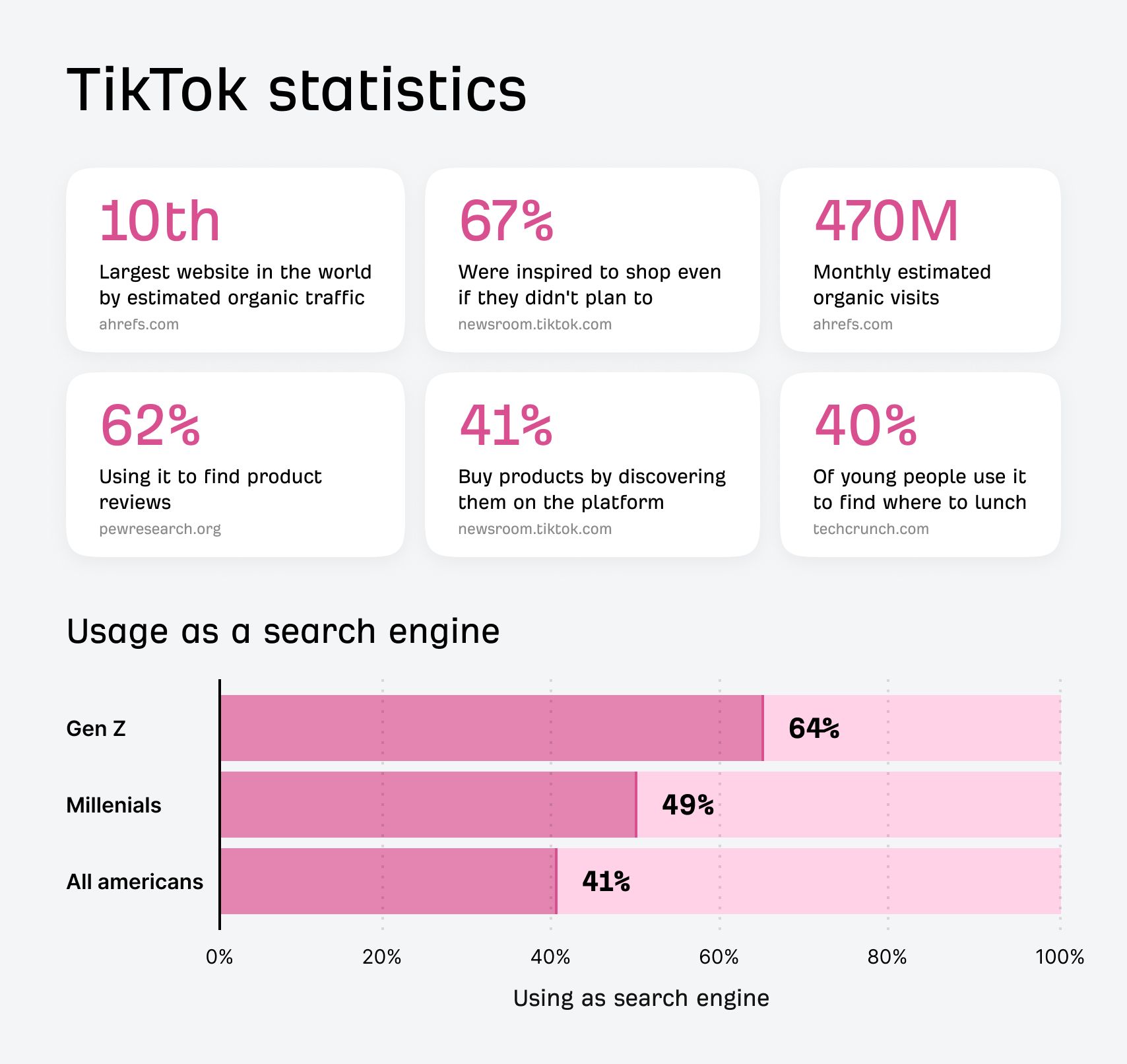
SEO has evolved from a “magic money tap” to a strong channel with new limitations. Sustainable growth now requires multi-channel resilience rather than Google dependency.
LLMs have lowered the barrier to content production, dramatically. You can now draft articles, generate ideas, and optimize copy faster than ever—and it shows. Nearly 74% of new web pages already include some form of AI-generated content.
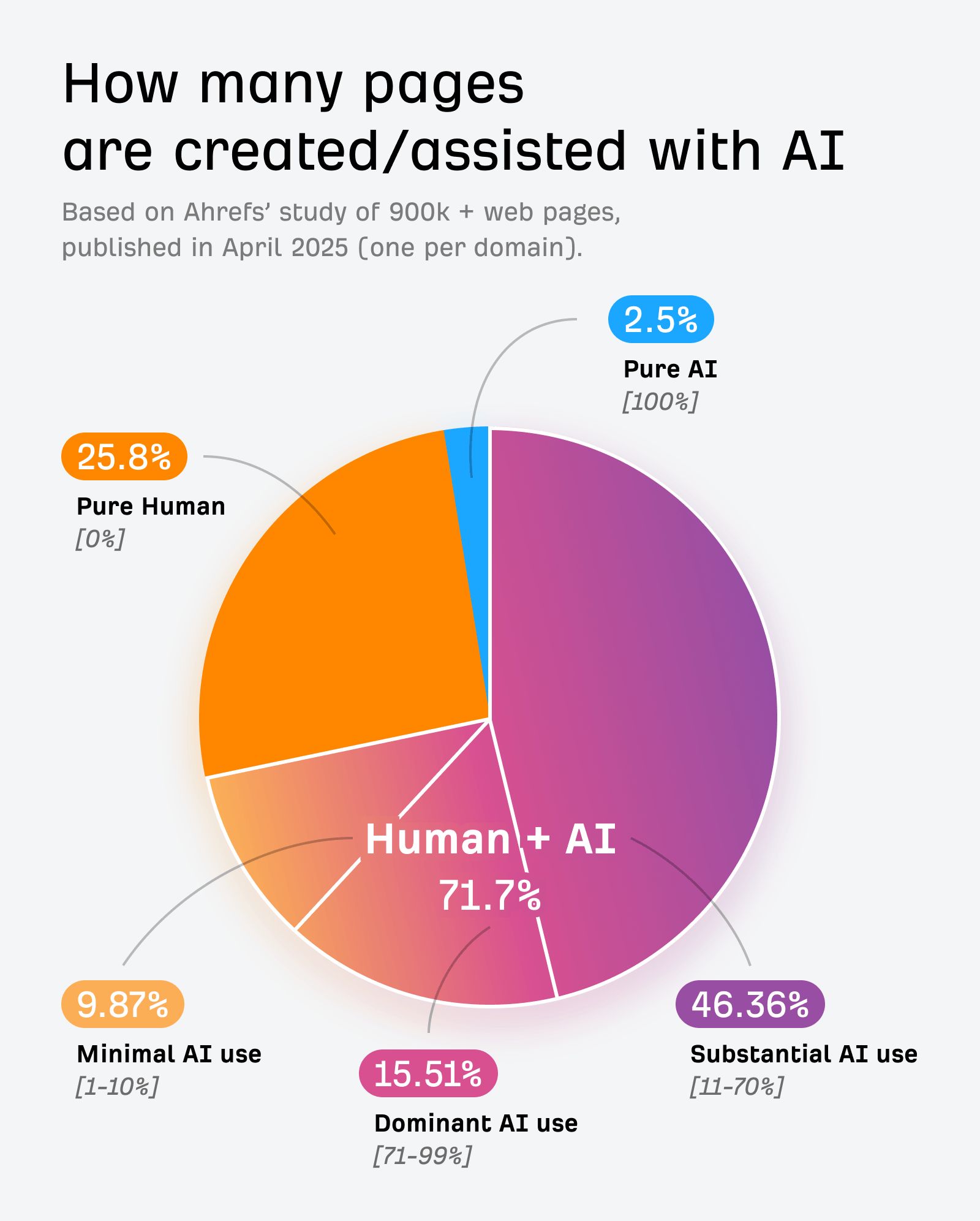
It’s a toothpaste-out-of-the-tube moment. The shift has happened, and there’s no putting it back. I think that in a few years, no one will care that AI was used to create content—it’ll be as normal as cars being built by robots.
Sure, maybe one day AI will replace some jobs. But right now, the real risk is not using it and falling behind those who do.
The key is to lean into your human strengths—insight, strategy, creativity, unique human experience—and let AI handle the repetitive parts. That’s how you make yourself harder to replace by AI.
One of the most valuable uses of AI in SEO today is content optimization. Tools like Ahrefs’ AI Content Helper can dramatically reduce the time it takes to identify search intent, find topical gaps, and compare your coverage against competitors.
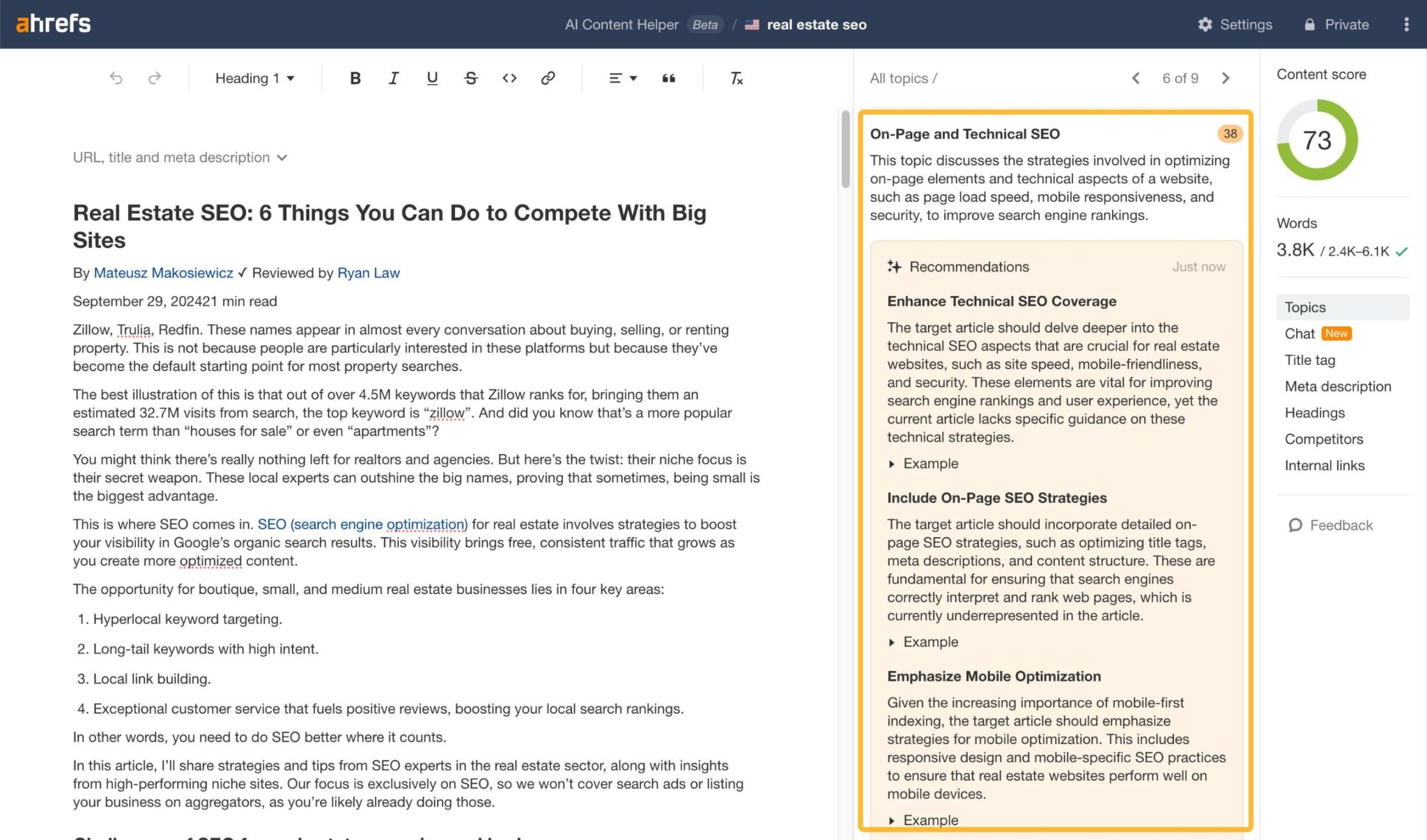
Check out how my colleague Louise used that AI tool to boost traffic by 72%.
The web is now overflowing with AI-generated content—most of it generic, shallow, and instantly forgettable.
To stand out, your content needs to show real human expertise. That means original research, firsthand experience, unique perspectives, and proprietary data—the kind of depth AI can’t fake.
This isn’t exactly a new trend in SEO—Google’s focus on EEAT has already pushed content quality to the forefront. But this time, it’s different. People are actively seeking a break from the flood of AI-generated content and turning to spaces where genuine, human-created content is more easily found.
At Ahrefs, we see this in action every day. My colleague Louise regularly breaks news about AI Search—almost every week—and her work is talked about, cited, linked and shared throughout the industry. That’s what real, authentic expertise looks like.
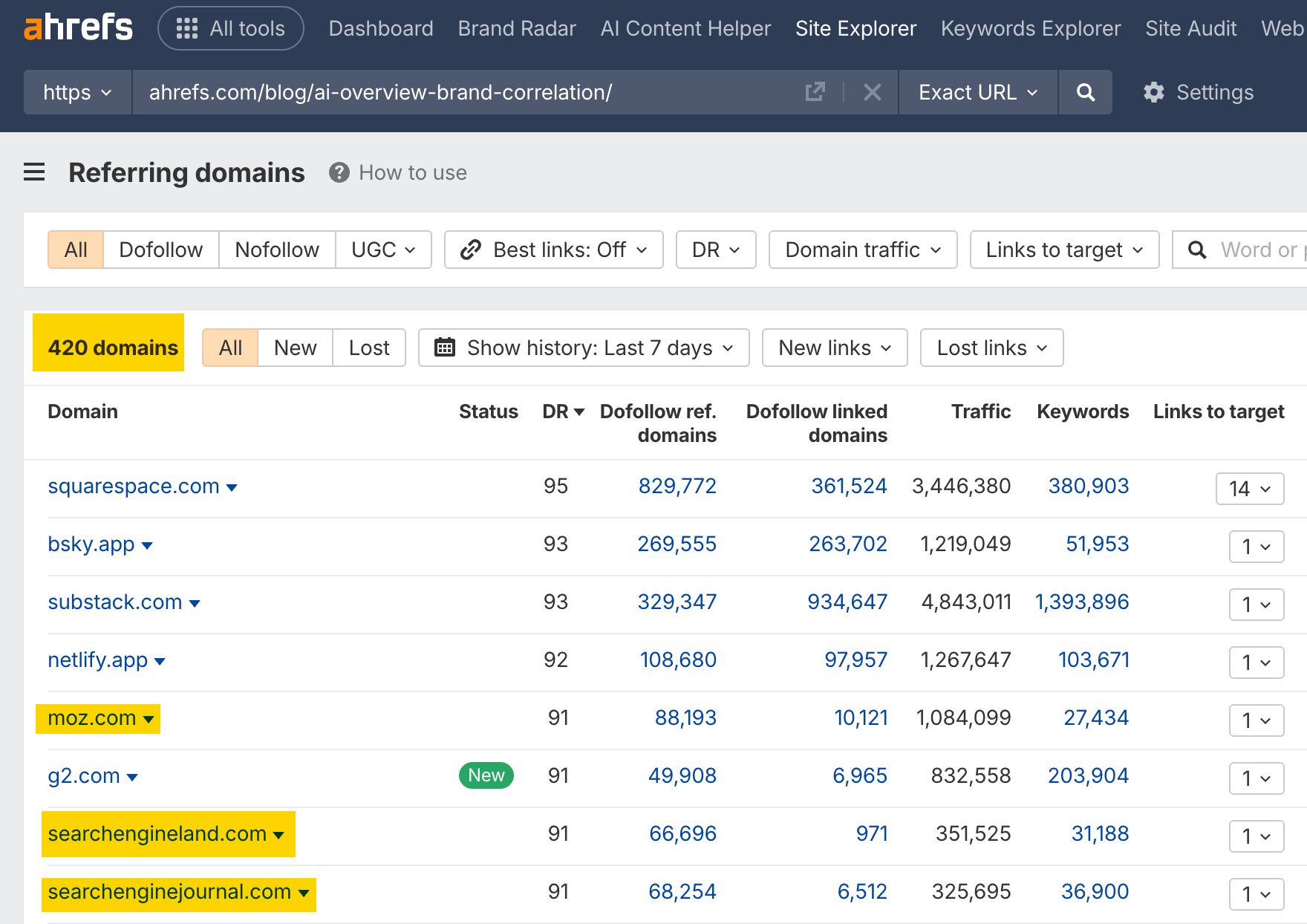
SEO involves juggling tons of data—rankings, traffic, backlinks, and keywords. Model Context Protocols (MCPs) make this data easier to work with by allowing LLMs to directly access SEO tools that support it and analyze your SEO data.
For example, you can use Claude’s MCP with Ahrefs to do things like:
- Finding good keywords for your blog that you haven’t targeted yet.
- Research international SEO expansion opportunities.
- Discover the top-ranking sites across any group of keywords.
- Get an idea of any unique, non-standard approaches to content from your competitors.
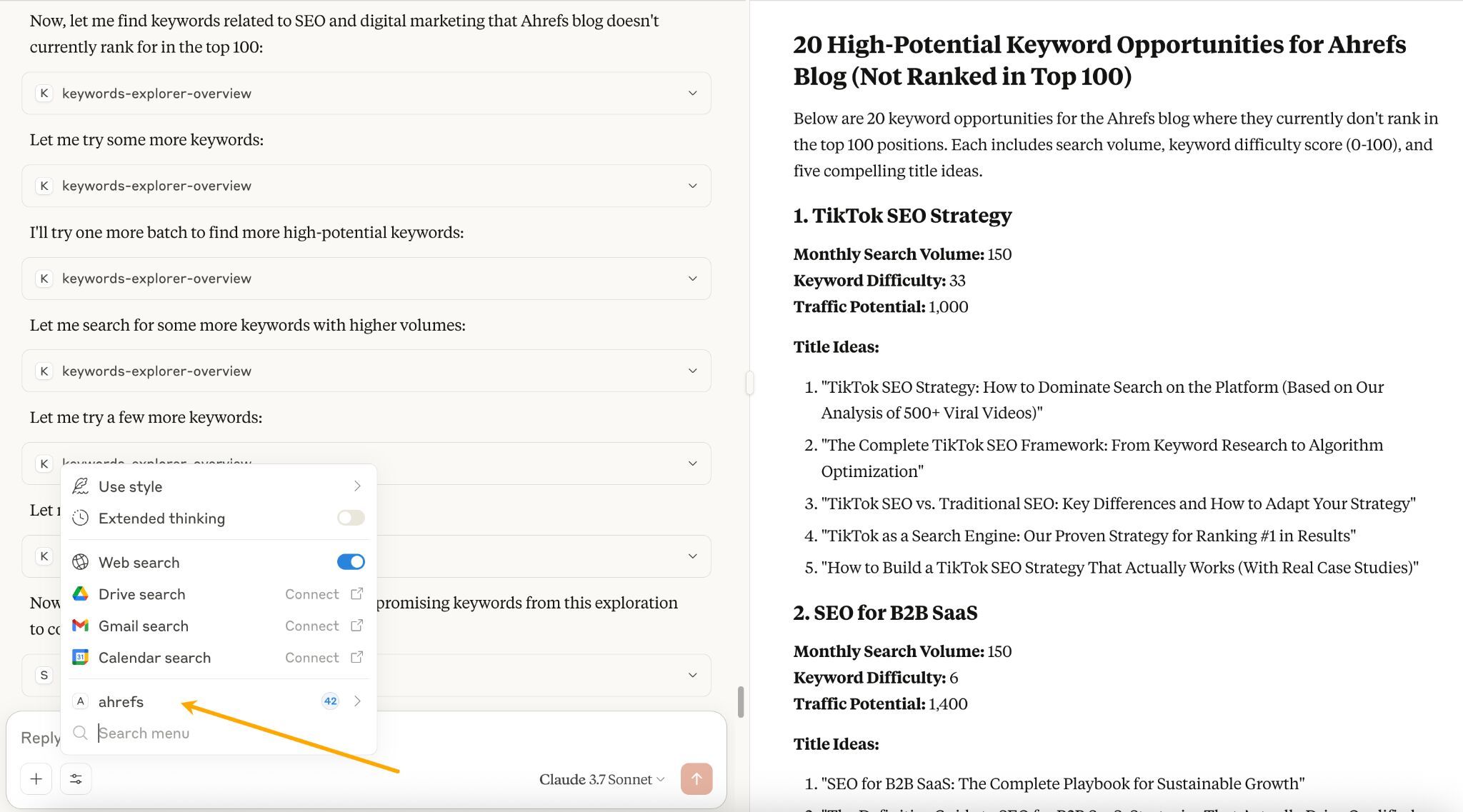
MCPs represent a shift from AI as assistant (helping you write after you do the research) to AI as analyst (doing the research, spotting the opportunities, and then helping you execute). For SEO, where data analysis is often the bottleneck between insight and action, this can change how SEO tools work forever.
Content that matches what people are actually searching for performs best.
AI systems, just like traditional search engines, are designed to serve users by providing the most relevant answers to their queries.
For example, as shown below, traditional Google Search, AI Mode, and ChatGPT all interpret the phrase “running shoes” in the same way.


What we used to call keywords or search queries are now often referred to as prompts in the world of AI, but that doesn’t mean keywords are no longer useful.
Keywords still play an important role in showing what people are curious about, helping you measure interest, demand, and growth trends for different topics you might want to target.
And since we don’t yet have reliable data on AI search volumes, keyword search volume is still a good way to estimate overall demand across both traditional and AI-driven searches.
Keywords also make it easier to monitor AI activity by grouping and summarizing similar prompts under a shared topic. Prompts people type into AI tools are often long and very specific to their situation.
For instance, a long prompt like “I’m trying to grow my small business blog and need some reliable content marketing tools that can help with keyword research, social media scheduling, and tracking results—what are some of the best options right now?” covers multiple sub-topics (keywords) within a broader theme.

Every prompt still has an underlying topic—or set of topics. Even when AI tools use query fan-out techniques (breaking down complex prompts into specific search queries), they’re ultimately organizing around core topics. Two prompts that seem completely different can actually be about the same thing at their core.
That’s why I like the approach that we took with Ahrefs Brand Radar. It gives you two levels of topic insights. You can see the exact keyword that triggered the AI query and optimize for that specific term. You can also look at the broader “parent topic” behind those keywords to reach a wider audience.
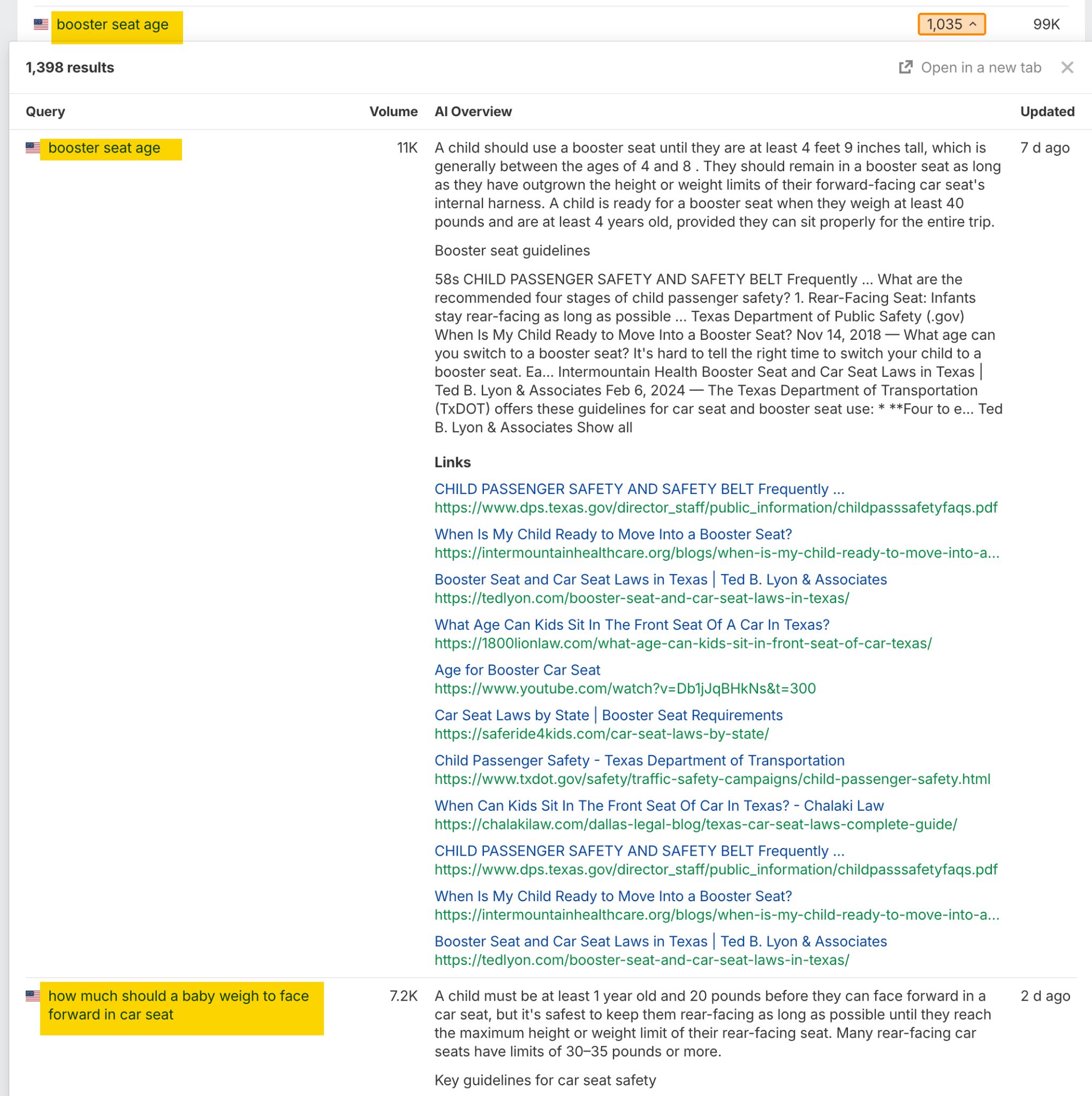
Last but not least, Google Search is still dominant and drives massive traffic. Based on our analysis of over 66k websites, Google is responsible for 40% of traffic to websites, compared to 0.24% from ChatGPT.

How you organize your content, and how easy it is for readers to skim and find key details, still play a big role in both visibility and readability.
Here’s an example: our SEO pricing study is one of the most frequently cited pages by AI on our site, even though it was published long before the whole AI craze began. I can say for sure that AI visibility wasn’t even a consideration when we created that page. What guided its structure was just optimizing for readability and basic on-page SEO best practices.

LLMs just love structure and clarity. It helps them cut or chunk large bodies of text into digestible, small parts that are easy to reference.
Strong credibility drives visibility and traffic indirectly, even in an AI-first search landscape. If you’ve built a reputable brand, that equity still pays dividends.
LLMs tend to reference trusted sources when generating answers. There’s a strong correlation between brand recognition and domain authority—established brands typically earn high Domain Ratings through years of accumulating quality backlinks, media mentions, and citations from other authoritative sources.
When I analyzed the top 1,000 websites most often mentioned by ChatGPT, one trend stood out: AI prefers high-authority sources. Most citations came from sites with a Domain Rating above 80, like Forbes, Mayo Clinic, and Harvard—brands that built trust through consistent quality and credibility.
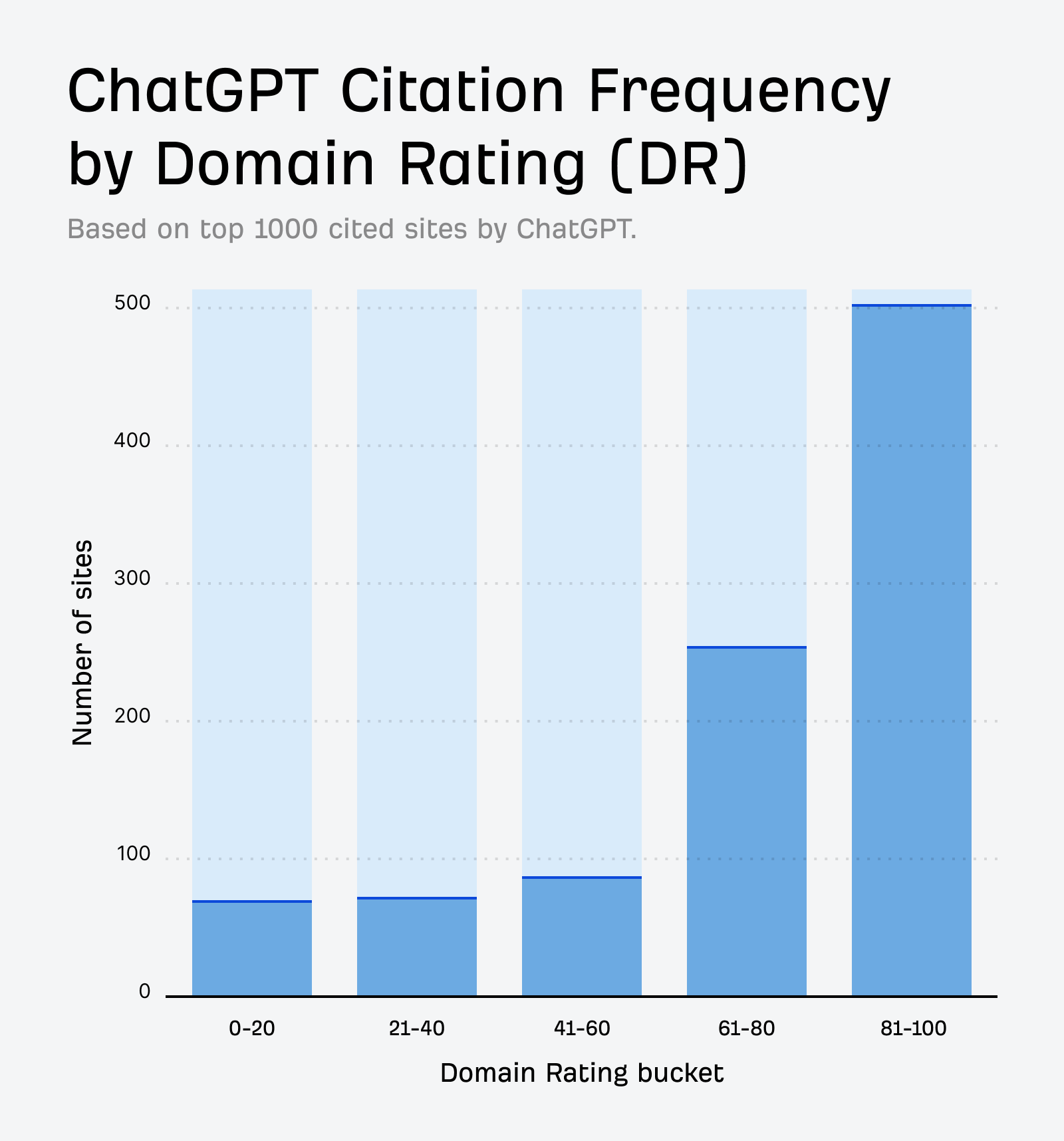
This creates a reinforcing cycle: strong brands earn more backlinks and mentions, which boosts their domain rating, which in turn makes them more likely to be cited by AI systems.
What’s more, brand signals make up the three most important factors to be included in AI Overviews (according to our study). These are:
- Branded web mentions. The instances of the brand being mentioned on any page on the web (linked and unlinked).
- Branded anchors. The anchor texts in the links pointing to a website.
- Branded search volume. Search volume of keywords that include a brand.
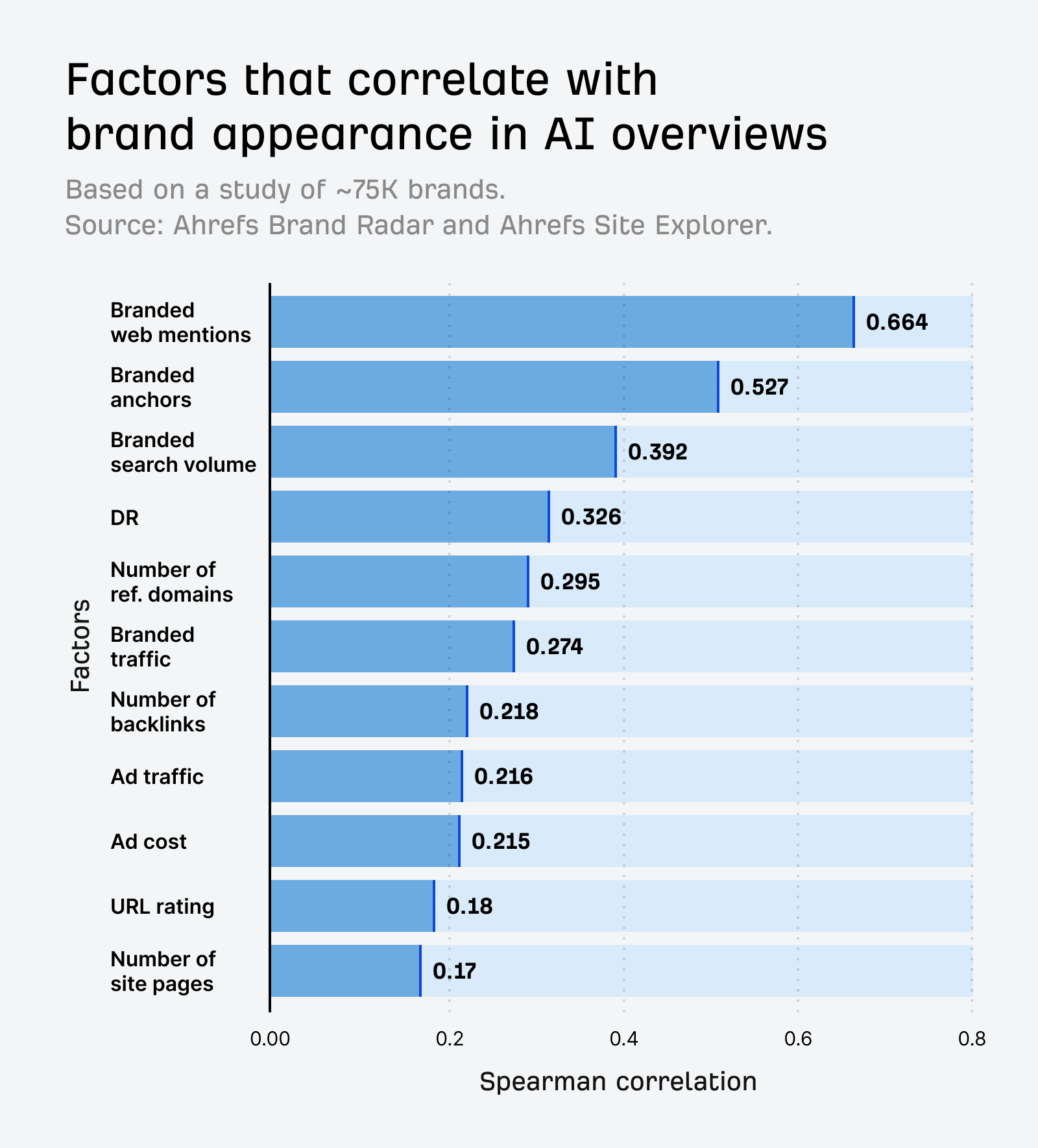
The takeaway is that building brand authority remains as important as ever, perhaps even more so in an AI-driven search landscape where trust signals matter tremendously.
Final thoughts
The good news? You don’t have to start over. Strong brands, high-quality content, and solid SEO fundamentals still win. What’s changing is where that visibility appears and how you measure success.
Right now, there’s still an early-mover advantage. Most brands haven’t begun optimizing for AI visibility, so those who start experimenting, learning, and building authority today will be ahead when everyone else catches on.
Got questions or comments? Let me know on LinkedIn.



